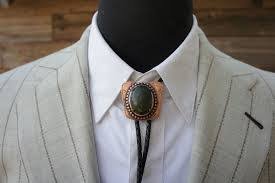For decades, the bolo tie has stood as a unique symbol of American style, blending the rustic elegance of the Western frontier with the refined craftsmanship of artisans. More than simple neckwear, it is a statement piece, a conversation starter, and a wearable heirloom. From ranchers on open plains to musicians on stage and professionals in urban settings, the bolo tie conveys individuality, heritage, and personal taste. However, one common challenge has historically affected owners of these accessories: the damaging effects of perspiration. For those who wear bolo ties regularly, sweat can tarnish metals, degrade leather cords, and shorten the lifespan of a cherished piece.
The development and increasing availability of sweat resistant bolo ties mark a notable evolution in accessory design. These items are engineered for durability and comfort while preserving aesthetic appeal. This article explores the history, materials, construction methods, and practical considerations that make modern bolo ties resilient. It also explains why sweat resistance is essential, how to choose a quality piece, and how to maintain these accessories for long-term enjoyment.
The History and Cultural Significance of Bolo Ties
To understand why the bolo tie continues to captivate, it helps to consider its origins. Emerging in the early 20th century, bolo ties were first popularized in the Southwestern United States, particularly Arizona and New Mexico. They became associated with Western heritage, cowboy culture, and Native American artistry. Artisans often incorporated turquoise, coral, and intricate silverwork into their designs, turning a functional accessory into a piece of wearable art.
By the mid-20th century, the bolo tie had gained recognition outside Western circles. Hollywood stars, politicians, and entertainers embraced the accessory for its versatility and charm. Today, bolo ties symbolize both tradition and innovation. The introduction of sweat resistant materials allows this heritage to continue without compromise, enabling wearers to enjoy these classic pieces in modern, active lifestyles.
Understanding the Anatomy of a Bolo Tie
A classic bolo tie consists of three main elements:
- The Cord: Traditionally braided leather, the cord loops around the neck and provides the structure of the accessory. Its ends are fitted with metal tips, known as aglets, which allow smooth adjustment and prevent fraying. Modern cords may also be made of synthetic materials designed to resist moisture and wear.
- The Slide (or Clasp): The centerpiece of the bolo tie, the slide secures the cord and serves as the decorative focal point. Slides are crafted from metals, stones, beadwork, or antique artifacts. Some slides feature intricate engraving or gemstone inlays, while others take minimalist forms.
- The Ends: The metal tips on each end of the cord help with threading through the slide and protect the cord from fraying. High-quality end pieces are crafted to complement the slide, providing both functional and visual balance.
Understanding these components is essential when selecting a bolo tie that will withstand the effects of daily wear, especially perspiration.
The Importance of Sweat Resistance
Perspiration is a natural bodily function, yet it can have significant consequences for accessories. Sweat contains water, salts, oils, and lactic acid. When these compounds contact leather or certain metals, they can initiate wear, corrosion, and discoloration.
- Metal Tarnishing and Corrosion: Sterling silver and brass, commonly used in traditional slides and tips, are prone to tarnish when exposed to moisture and salts. Prolonged exposure can result in darkened or greenish surfaces, obscuring intricate details and potentially causing permanent corrosion.
- Leather Degradation: Leather cords can absorb sweat, becoming stiff, brittle, or cracked over time. Oils in sweat may also break down fibers and dyes, leading to discoloration and reduced tensile strength.
- Comfort and Hygiene: A sweat-soaked cord can irritate the skin, create odors, and harbor bacteria, presenting hygiene concerns for daily wear.
Modern sweat resistant designs address these challenges, ensuring longevity, comfort, and reliability without compromising style.
Materials and Construction for Longevity
Creating a durable and moisture-resistant bolo tie involves selecting the right materials and ensuring meticulous construction.
Advanced Metals and Finishes
The slide and end tips are critical in resisting moisture. Materials often used include:
- Surgical Stainless Steel: Highly resistant to corrosion, it retains its shine and is hypoallergenic.
- Titanium: Lightweight, strong, and corrosion-proof. Titanium slides can be anodized for vibrant colors without using paints or coatings.
- Niobium: Hypoallergenic and corrosion-resistant, with the ability to display anodized colors.
- Protective Platings: Gold vermeil or rhodium plating provides additional moisture protection for metals that might otherwise tarnish.
Cords and Treatments
The cord is most exposed to sweat. Options include:
- Waxed Leather: Leather treated with natural wax or sealants resists moisture while retaining its classic appearance and feel.
- Synthetic Braids: Materials such as polyurethane leather, nylon paracord, or advanced polymers mimic leather but are inherently moisture-resistant and durable.
- Silk or Blend Cords: For formal wear, silk or satin blends with protective coatings offer elegance and durability.
Secure Construction
High-quality sweat resistant bolo ties often feature sealed aglets. Epoxy or solder is used to prevent moisture from entering the cord’s core, protecting it from damage at vulnerable points.
Identifying a High-Quality Bolo Tie
When selecting a durable accessory, pay attention to these factors:
- Product Descriptions: Look for terms such as “sweat resistant,” “moisture resistant,” “tarnish-free,” or “hypoallergenic.”
- Materials: Verify the use of stainless steel, anodized metals, waxed leather, or synthetic cords.
- Craftsmanship: Examine slides and tips for secure attachment and consistent finish.
- Brand Reputation: Artisans or brands known for durability and quality materials often provide the most reliable options.
Styling Your Bolo Tie
Sweat resistant bolo ties are versatile and can complement various outfits:
- Western and Casual: Pair a stainless steel slide with a black waxed leather cord and denim or a casual blazer.
- Business and Formal: Minimalist designs in titanium or rhodium-plated silver can serve as a unique alternative to traditional neckties in professional settings.
- Artistic and Bohemian: Colorful anodized metals, geometric slides, or decorative stones can create a distinctive focal point in creative ensembles.
Care and Maintenance
Even durable bolo ties require proper care:
- Cleaning: After wear, wipe the slide, cord, and tips with a soft, slightly damp cloth to remove oils and salts. Dry thoroughly.
- Storage: Store flat in a dry location or soft pouch to prevent scratches and moisture exposure.
- Periodic Deep Cleaning: Use specialized cloths for metal slides or mild soap solutions for synthetic cords to maintain their appearance.
- Leather Maintenance: Waxed leather cords may benefit from occasional re-waxing or conditioning to maintain flexibility and durability.
Common Questions
Are sweat resistant bolo ties waterproof?
They are designed to resist perspiration and incidental moisture but are not intended for full submersion unless specified.
Can traditional designs incorporate modern materials?
Yes, classic Southwestern or minimalist styles can include sweat resistant metals and cords without losing authenticity.
Is there a significant cost difference?
Premium materials may increase cost slightly, but the longevity and reduced replacement needs justify the investment.
Do modern cords compromise the feel of traditional leather?
High-quality synthetic or treated cords closely replicate the look and feel of leather while providing enhanced durability.
How often should I clean and maintain my bolo tie?
After each use, lightly wipe to remove perspiration. Conduct a deeper clean once a month if worn frequently, adjusting care based on the materials.
Everyday Use and Lifestyle Integration
Bolo ties are no longer limited to formal or ceremonial wear. Modern designs integrate seamlessly into daily life. Professionals in warmer climates, outdoor enthusiasts, and performers can now wear these accessories confidently without worrying about damage from sweat. This functionality makes bolo ties not only a fashion statement but also a practical tool for those who value durability.
Conclusion
The evolution of the bolo tie reflects its enduring appeal and practical adaptation for modern lifestyles. Sweat resistant materials, treated or synthetic cords, and meticulous construction ensure that this iconic accessory can be worn confidently and stylishly. By selecting high-quality designs, maintaining proper care, and understanding their unique features, wearers can enjoy the elegance, cultural significance, and functionality of bolo ties for years to come. These innovations preserve tradition while embracing the demands of contemporary living, making the bolo tie a timeless and practical accessory.



